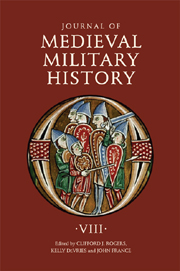Book contents
- Frontmatter
- Contents
- 1 People against Mercenaries: The Capuchins in Southern Gaul
- 2 The Last Italian Expedition of Henry IV: Re-reading the Vita Mathildis of Donizone of Canossa
- 3 Jaime I of Aragon: Child and Master of the Spanish Reconquest
- 4 Numbers in Mongol Warfare
- 5 Battlefield Medicine in Wolfram's Parzival
- 6 Battle-Seeking, Battle-Avoiding or perhaps just Battle-Willing? Applying the Gillingham Paradigm to Enrique II of Castile
- 7 Outrance and Plaisance
- 8 Guns and Goddams: Was there a Military Revolution in Lancastrian Normandy 1415–50?
- The Name of the Siege Engine trebuchet: Etymology and History in Medieval France and Britain
- Journal of Medieval Military History 1477–545
7 - Outrance and Plaisance
Published online by Cambridge University Press: 12 September 2012
- Frontmatter
- Contents
- 1 People against Mercenaries: The Capuchins in Southern Gaul
- 2 The Last Italian Expedition of Henry IV: Re-reading the Vita Mathildis of Donizone of Canossa
- 3 Jaime I of Aragon: Child and Master of the Spanish Reconquest
- 4 Numbers in Mongol Warfare
- 5 Battlefield Medicine in Wolfram's Parzival
- 6 Battle-Seeking, Battle-Avoiding or perhaps just Battle-Willing? Applying the Gillingham Paradigm to Enrique II of Castile
- 7 Outrance and Plaisance
- 8 Guns and Goddams: Was there a Military Revolution in Lancastrian Normandy 1415–50?
- The Name of the Siege Engine trebuchet: Etymology and History in Medieval France and Britain
- Journal of Medieval Military History 1477–545
Summary
Modern writers on medieval deeds of arms often use the terms à outrance to describe combats fought “using the normal weapons of war” and à plaisance to describe combats using “specially modified weapons with sharp edges removed or blunted.” The definitions quoted are from Richard Barber and Juliet Barker's 1989 Tournaments: Jousts, Chivalry and Pageants in the Middle Ages. Barker's earlier work, The Tournament in England 1100–1400, defines outrance and plaisance with almost identical terms, as do Maurice Keen's Chivalry, Richard Kaeuper's Chivalry and Violence in Medieval Europe and Katie Stevenson's Chivalry and Knighthood in Scotland, 1424–1513. This definition can be traced back at least as early as 1918, when Francis Henry Cripps-Day's The History of the Tournament defined combat with “arms of war” as à outrance and with blunted arms of courtesy as à plaisance. However, during the fifteenth century, when the terms came into use to describe specific types of combat and were most often used to describe contemporary deeds of arms, writers in Burgundy, France, Spain and England used the terms very differently.
The use of sharp rather than blunted weapons was not the consideration that distinguished outrance from plaisance. Combats à plaisance could be fought with sharp weapons, and arms à outrance were sometimes fought with wooden clubs. Instead, deeds of arms à outrance were distinguished by the willingness of the combatants to fight until one side or the other was captured or killed, unless the judge or judges stopped the fight.
- Type
- Chapter
- Information
- Journal of Medieval Military History , pp. 155 - 170Publisher: Boydell & BrewerPrint publication year: 2010



